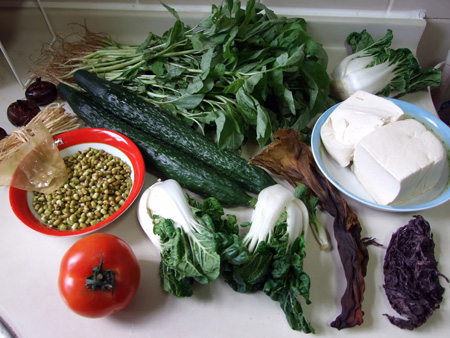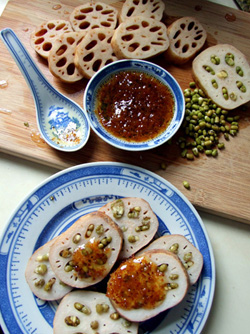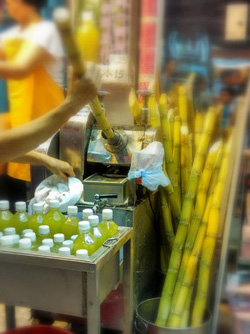|
Skin problems are common in the modern cities, individuals are likely resulted from constitutional or dietary influences rather than environmental hygienic problems. Eating healthy has a positive impact on the skin, since many skin problems are a reflection of internal changing of the body. A well-planned diet ensures the body to absorb essential nutrients and to remove toxins effectively, that facilitate the skin condition to heal.
China has a long history in dietary practice to promote health, and has accumulated a rich experience in it. Improper eating is an important factor for the frequent flare up of skin itching. Traditional Chinese medicine (TCM) believes that unhealthy eating habits such as over consumed spicy and greasy food, too much wine or coffee are harmful to the spleen and stomach functioning, leading to damp-heat accumulation internally and then triggering skin itching. A careful food selection and practicing some dietary taboos help the body to stay in a calm yet optimal functional state, which surely speed up the recovery.

Severe itching that accompanies with skin rashes or swelling should eat more anti-inflammatory and soothing food, such as amaranth, bok choy, kelp, laver, mung bean, tomato and cucumber.
|
Dietary suggestions for Itchy skin
TCM dietary suggestions for itchy skin include:
 |
Keep a plain and nourishing diet, drink adequate amount of water, and cut down on spicy, deep fried and dehydrated foods. The daily diet should include a small portion of fat from both animal and plant sources, which are beneficial for the skin in holding moisture. |
 |
Fresh vegetables and fruits are important, because they contain rich vitamins and minerals that promote healthy skin cell growing. Stimulating ingredients such as chili pepper, pepper, raw ginger and garlic, alcohol, coffee, tea and cigarette aggravate the itchy conditions, and thus should be avoided, especially during the outbreak period. |
 |
Foods like fish, shrimp, crab, mutton, goose meat, and bamboo shoot are common triggers for allergic reactions; they should be taken with caution. Some tonic ingredients should also be avoided during the outbreak period. |
 |
Generalized itching in the middle ages and elderly people is often associated with under-nourished skin according to TCM understanding, individuals should eat more food with yin nourishing and blood replenishing properties, such as spinach, pine nut, animal livers, sea cucumber, litchi, grape, black sesame and egg. |
 |
When the itching is serious and accompanied with skin rashes or swelling, it is beneficial to eat more ingredients that have anti-inflammatory and soothing effects, such as amaranth, bok choy, leaf mustard, taro, kelp, laver, chicken, snake meat, mung bean, cucumber, bitter melon, purslane and green tea. |
 |
Since itchy skin can present in different disharmony patterns, TCM physicians may recommend specific food ingredients for their patients. Some suggestions are as below: |
| Itchy skin types |
Suggested food ingredients |
| Over-heated blood |
Ingredients with cooling and skin soothing properties: Chinese radish, wax gourd, watermelon, bitter melon, musk-melon, loofah, bottle gourd, lotus root, tomato, celery, water spinach, wild rice stem, water chestnut, water caltrop, pear, apple, citrus, banana, mulberry, millet, barley, wheat, mung bean, bean curd, coix seed, buckwheat, kelp, laver, arrowhead, duck egg, and field snail |
| Wind and cold attacking the body surface |
Ingredients to promote sweating: perilla leaf, fresh ginger, cinnamon, coriander, and green onion |
| Blood deficiency |
Ingredients to promote blood production and lubricate the skin: mulberry, pine nut, black fungus, white fungus, spinach, carrot, pork, mutton, animal livers, soft-shelled turtle, mullet, sea cucumber, pear, grape, daily products, soymilk, lily bulb, egg, ricefield eel, and snake meat |
| Severe itchiness disturbing sleep |
Ingredients to calm down the spirit and promote sleep: lotus seed, lily bulb, sour jujube seed, orange, papaya, longan aril, wheat, husked sorghum, pig's heart, oyster, yellow croaker, mushroom, reishi mushroom, and seed of oriental arborvitae |

|

|
|
|
Lotus root cool dish and sugar cane juice
|
Chinese healthy recipes for itchy skin
Foods are just as herbs that can tonify, cleanse and regulate the body. In every Chinese family, special meals are prepared for the sick or weak family members, either for the purposes of symptom relief, promoting full recovery, combating external seasonal influences, against adverse effects of drugs or general enhancement. Such understanding of certain foods as medicine has been passed down through generations; housewives are familiar in selecting particular ingredients to make tasteful yet healthy dishes. With proper selection and preparation of food, diet can be a way for promoting health on regular basis. Simple recipes for itchy skin are listed below:
 |
Mung bean (20g), fresh lotus root (300g), and sweet osmanthus sauce. Soak the mung bean in water overnight, wash the lotus root and chop into thick pieces, use the beans to stuff into the holes of the lotus pieces, steam under high heat for 30 minutes or until they thoroughly cooked, turn off the heat, pour the sweet osmanthus sauce on top. The dish can serve as a cool dish or dessert that aids itchy conditions due to over-heated blood. |
 |
Honeysuckle flower (10g) and fresh loquat fruit (4 pieces). Peel and remove the seeds of loquat fruits, pound the flesh slightly, put the flesh and the honeysuckle flower in a cup and infuse into boiling water, cover for five minutes. Drinking regularly is beneficial to itchy skin due to wind-heat attacking the body surface. |
 |
Fresh perilla leaf (15g), and rice (50g). Chop up the perilla leaf and put aside; boil the rice with 1000 ml of water, bring to a boil quickly and then simmer under low heat, when the liquid turns thick, add in the perilla leaf and stir for a while, turn off the heat and add rock sugar to taste. Serve warm, eat in the morning or empty stomach. This is suitable for itchiness due to wind-cold attacking the body surface or food allergic. |
 |
Rehmannia root (50g), one pig's foot (500g), ginger (4 thick slices) and white part of green onion (1/2 cup). Wash and chop the first two ingredients into big pieces, blanch the pig's feet in boiling water for 5 minute; put all the ingredients in a pot, fill with water to about 2cm from the top; bring to a boil quickly, then simmer for about 2 hours or until the meat and skin fall off the bones (if the water level becomes too low, add warm water, 1 to 2 cups at a time); take out the herb from the pot, season with salt, rice wine, and sesame oil to taste, turn to medium heat and cook for another 30 minutes, turn off the heat and serve hot. The dish can be divided for several meals (finish within the week). The herb can replenish blood and moist dryness, and the pig's foot is rich in collagen. This is good for itchiness with dry skin. |
 |
Red sage root (30g), notoginseng (10g), one baby chicken and ginger (4 thick slices). Take off the chicken skin, clear its chest, stuff the herbs into the chest; put the chicken in a clay pot, fill with water to cover it, simmer under low heat until it is tendered; take out the herb from the chicken's chest, season with salt, rice wine, sesame oil and ginger to taste, cook under medium heat for another 30 minutes, turn off the heat and serve hot. The chicken can be divided for several meals, eat one chicken a week. The herbs promote blood circulation and resolve stasis. This stew is suitable for itchy conditions associated with blood stasis, such as hives around menstrual periods. |
 |
Dictamnus root bark (15g), rice bean (30g) and carp (500g). Decoct the root bark to make a solution first; use the solution and the rice bean and fish to boil a soup. Serve hot, drink the soup and eat the fish. This is beneficial to itchy conditions due to damp-heat accumulation. |
 |
Dried white fungus (6g), and rock sugar (15g). Clean and soak the white fungus in warm water for one hour, cook with 1000ml of water, bring to a boil quickly and then simmer for two hours, add in the sugar and serve warm. This is suitable for itchy conditions associated with heat symptoms or yin deficiency. |
 |
Pond loach (300g), pork ribs (200g), red dates (30g), ginger (2 thick slices) and white part of green onion (1/4 cup). Put the loach and pork ribs in boiling water and blanch for 3 minute, the loach has to clean the organs and rub away mucus on the skin; put the pork ribs and ginger slices in a pot and boil with 1500ml of water for one hour under medium heat, then add in the loaches and red dates, simmer for another hour, season to taste and serve warm. Drink the soup and eat the meats. This is beneficial to itchy conditions with a weakened body. |
 |
Schisandra (6g), huai wheat (30g) and lotus plumule (10g). Decoct to make a tea and add sugar to taste. Drink every day. This drink clears heart fire and calms down the spirit, which are suitable for severe itching that disturbs sleeping. |
 |
Fresh lily bulb (30g) and mung bean (30g); boil with 1000ml of water until the ingredients are fully tendered, add sugar to taste. As porridge for breakfast or evening. |
 |
Fresh sugarcane juice 300ml every day. |
 |
Vinegar and brown sugar for 50g each, and fresh ginger (30g), decoct to drink. This is suitable for any itchy condition during outbreak. |
|